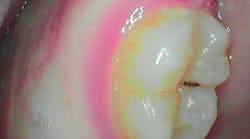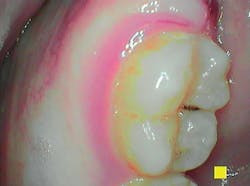By Amber Auger, RDH, MPH
The roles of the dental hygienist are an educator, clinician, researcher, manager and an advocate for prevention of diseases.1 We have the ability to address the patients’ high-risk factors for tooth decay, periodontal disease, and systemic diseases while bridging the educational gap between periodontal health and systemic health. This unique role could save the life of a patient by identifying symptoms for life-threatening conditions.
Influential patient education is essential to establishing change in the life of the patient, and an intraoral camera elevates our ability to connect the education to the patient. Acteon has created the SoproCare camera that differentiates the color of tissues to reveal inflammation.2
SoproCare was created for dental clinicians to educate during periodontal and prophylaxis treatment.2 The camera offers three modes: Perio mode, Cario mode, and Daylight Mode. Each mode has been designed to engage patients and increase compliance to treatment recommendations.
Perio mode allows the clinician to provide a more complete assessment of the patient’s oral health by rapidly assessing gingival inflammation, plaque, and calculus.2 Through the usage of LED lights, the camera demonstrates new plaque, which is shown as white, and the old plaque that is demonstrated in a yellow and orange shade.2
This allows patients to see the bacteria that was left behind even after their most recent brushing, which increases their need to change their oral health regime. The degree of gingival inflammation is detected with a light pink color to represent mild inflammation through a deep magenta to represent severe inflammation.2
In addition, the images allow the clinician to identify specific areas for the patient to improve on, and the images can be used document current oral conditions. The initial images can serve as a baseline to track improvements or progression of disease. Clinicians can praise the patients’ enhanced home care techniques during their preventive care appointments.
Cario mode works to diagnose caries in the earliest stages. It increases case acceptance and is ideal for patient communication.2 Acteon uses the principles of autofluorescence, which utilizes blue LED to improve the clinical examination and increases the diagnostic capabilities of the clinician, highlighting the decay.2 “Enamo-dentinal caries are clearly revealed by the bright red color in the Cario mode.”2 This allows clinicians to have earlier detection and less invasive treatment to preserve the patient’s tooth structure without additional radiation.
The Daylight mode delivers magnification that is up to 100 times stronger, allowing for detection of details the naked eye cannot see. The Daylight mode helps the clinician to identify microfractures, leaking margins, and implant sites.2 Portrait, smile, intraoral, and Macrovision settings allow the clinician to capture a wide range of images from one device, saving time and increasing effectiveness of education.2
The camera offers a focus ring to allow the clinician to obtain in-focus, high-quality images in four different focal depths.2 Capturing images is achieved by tapping the rheostat, or gently rolling a finger over the capture button that is located at the top of the camera. Designed to rest near one’s handpiece attached to the unit for easy accessibility, the camera can be easily incorporated into each hygiene appointment.
The SoproCare camera has Sopro rubber tips that are placed at the intraoral tip to protect against ambient light. These tips are autoclavable, and allow the clinician to hug the tooth with additional stability.
A clinical study conducted by Arau´jo M-R, et al., demonstrated that using an intraoral camera improves the clinical, behavioral, and psychological determinants of periodontal health.3 Providing solutions for increase treatment acceptance, patient education, and documentation the SoproCare camera allows the hygienist educator to powerfully connect with the patient. Educating patients with an Intraoral camera will increase the patients’ perceived need for treatment recommendations and result in a higher rate of treatment compliance. RDH
References
1. ADHA. Professional Roles of a Dental Hygienist. Available at: https://www.adha.org/resources-docs/714112_DHiCW_Roles_Dental_Hygienist.pdf. Accessed July 3, 2017.
2. Acteon SoproCare. Available at: https://www.acteongroup.com/en/my-products/imaging/diagnostic-camera/soprocare. Accessed July 3, 2017.
3. Arau´jo M-R, Alvarez M-J, Godinho CA, Pereira C. Psychological, behavioral, and clinical effects of intra-oral camera: a randomized control trial on adults with gingivitis. Community Dent Oral Epidemiol 2016. © 2016 John Wiley & Sons A/S. Published by John Wiley & Sons Ltd.
Amber Auger, RDH, MPH, is a hygienist with experience in multiple clinical settings, including facilities abroad. Amber obtained a master’s degree in public health from the University of New England and a bachelor’s in dental hygiene from the University of New Haven. She holds a part-time position at an elite dental office in Boston. Amber Auger is a key opinion leader for several dental companies, speaker and published author, and can be contacted at amberaugerrdh.com.






